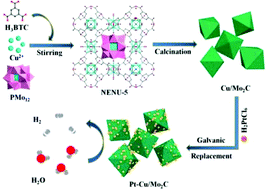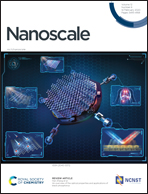Pt decorated POMOF-derived constructions for efficient electrocatalytic hydrogen evolution†
Abstract
Molybdenum carbide (Mo2C) has been universally investigated in the field of catalysis due to its d-band electronic structure, which is similar to those of Pt-group metals. However, practical application of Mo2C in electrocatalytic hydrogen evolution is limited due to its low surface area and inadequate active sites caused by high temperature pyrolysis. Therefore, fabrication of Mo2C-based nanostructures with well-defined morphologies and high porosity remains a great challenge. In this work, we developed an efficient approach for decorating Pt–Cu nanocrystals on Mo2C octahedrons (Pt–Cu/Mo2C) using thermal treatment of polyoxometalate (POM)-based metal–organic frameworks (NENU-5) followed by galvanic replacement with H2PtCl6. The Pt–Cu/Mo2C nanostructure exhibits an ultrasmall overpotential of 12.9 mV (j = 10 mA cm−2) in an acidic medium for electrocatalytic hydrogen evolution, which is much lower than those of bare Mo2C, Pt/Mo2C, and commercial Pt/C catalysts. More importantly, the Pt–Cu/Mo2C nanostructure delivers an exceptional cycling stability with a negligible decay over 10 000 cycles. The present work demonstrates potential guidance for the design of efficient and durable catalysts to boost electrocatalytic hydrogen evolution.



 Please wait while we load your content...
Please wait while we load your content...